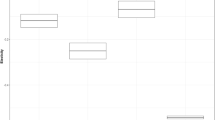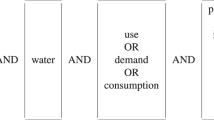Abstract
Heteroscedastic additive and multiplicative models are proposed to disaggregate household data on water consumption from Athens and provide individual consumption estimates. The models adjust for heteroscedasticity assuming that variances relate to covariates. Household characteristics that can influence consumption are also included into models in order to allow for a clearer measurement of individual characteristics effects. Estimation is accomplished through a penalized least squares approach. The method is applied to a sample of real data related to domestic water consumption in Athens. The results show a greater consumption of water for males while the single-female households are these that use the lowest quantities of water. The consumption curves by age and gender are constructed presenting differences between the two sexes.
Similar content being viewed by others
References
Chesher A (1997). Diet Revealed?: semiparametric estimation of nutrient intake-age relationships. J Roy Stat Soc A160: 389–428
Engle RF, Granger CWJ, Rice JA and Weiss A (1986). Semiparametric estimates of the relation between weather and electricity sales. J Am Stat Assoc 81: 310–320
Fu WJ (2003). Penalized estimating equations. Biometrics 59: 126–132
Green PJ and Silverman BW (1994). Nonparametric regression and generalized linear models: a roughness penalty approach. Chapman & Hall, London
Liang KY and Zeger SL (1986). Longitudinal data analysis using generalized linear models. Biometrika 73: 13–22
Linhart H and Zucchini W (1986). Model selection. Wiley, New York
Martinez-Espineira R (2002). Residential water demand in the northwest of Spain. Environ Resour Econ 21: 161–187
Mukhopadhyay A, Akber A and Al-Awadi E (2001). Analysis of freshwater consuption patterns in the private residences of Kuwait. Urban Water 3: 53–62
Opaluch JJ (1982). Urban residential demand for water in the United States. Land Econ 58: 225–227
Prentice RL and Zhao LP (1991). Estimating equations for parameters in means and covariances of multivariate discrete and continuous responses. Biometrics 47: 825–839
Vasdekis VGS and Trichopoulou A (2000). Nonparametric estimation of individual food availability along with bootstrap confidence intervals in household budget surveys. Stat Probab Lett 46: 337–345
Wahba G (1975). Smoothing noisy data with spline functions. Numerische Mathematik 24: 309–317
Wang YD, Byrne J, Song JS, Chen Y (1998) The 1992-97 panel study of residential water conservation impact. Center for Energy and Environmental Policy, University of Delaware
White H (1980). A heteroskedasticity-consistent covariance matrix and a direct test for heteroskedasticity. Econometrika 48: 817–838
Zhou SL, McMahon TA, Walton A and Lewis J (2000). Forecasting daily urban water demand: a case study of Melbourne. J Hydrol 236: 153–164
Author information
Authors and Affiliations
Corresponding author
Rights and permissions
About this article
Cite this article
Karlis, D., Vasdekis, V.G.S. & Banti, M. Heteroscedastic semiparametric models for domestic water consumption aggregated data. Environ Ecol Stat 16, 355–367 (2009). https://doi.org/10.1007/s10651-007-0055-7
Received:
Revised:
Published:
Issue Date:
DOI: https://doi.org/10.1007/s10651-007-0055-7




